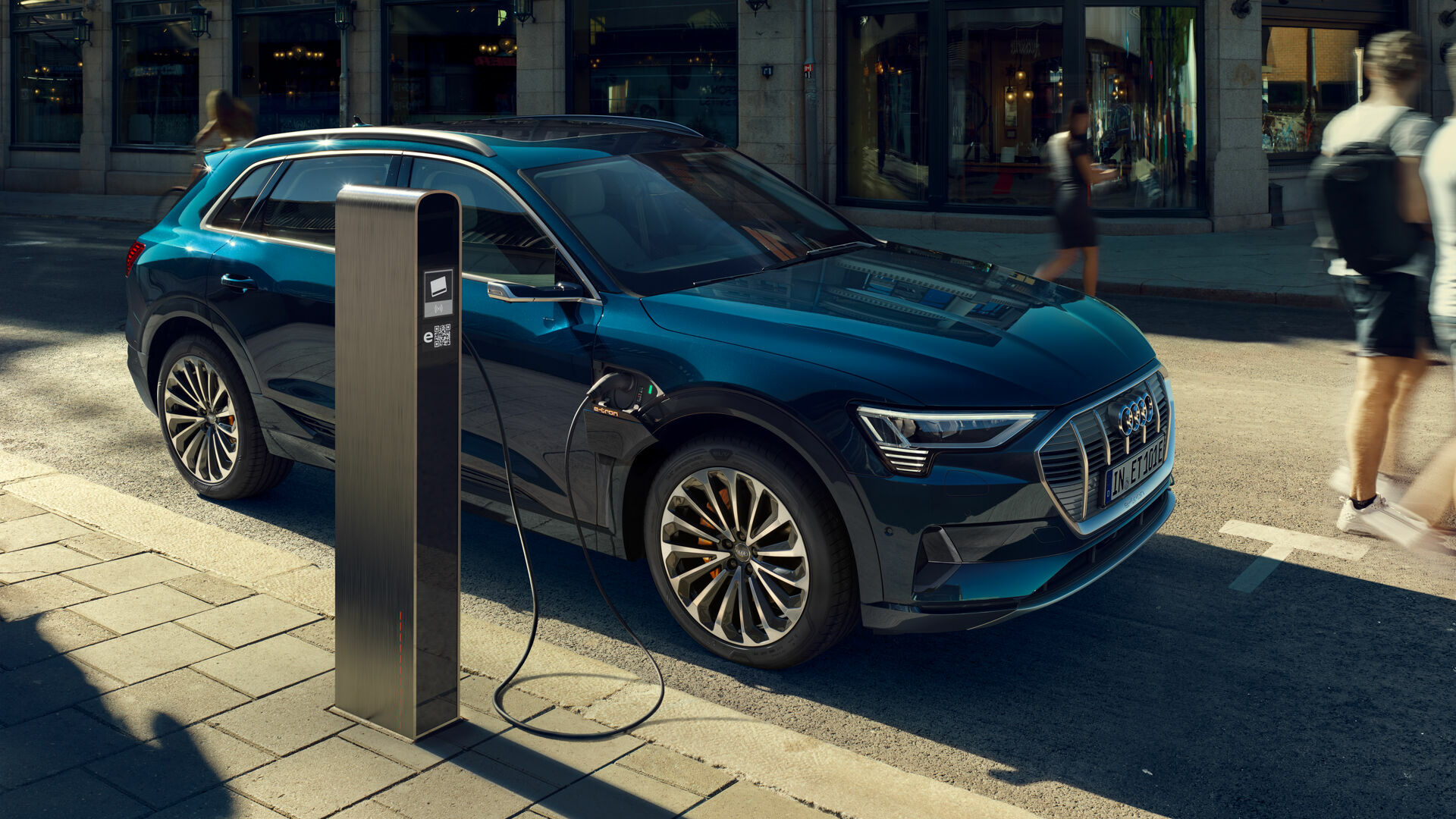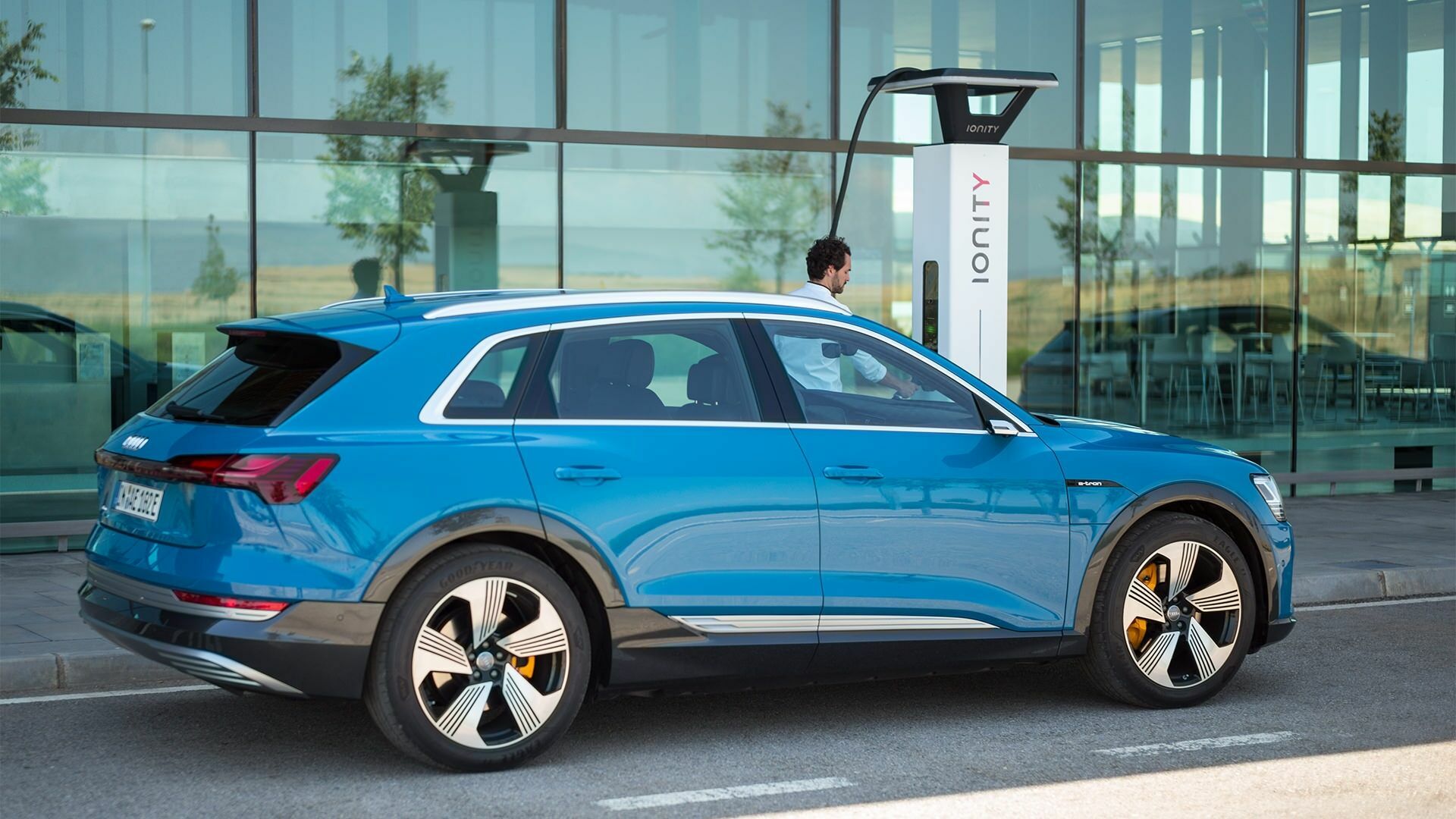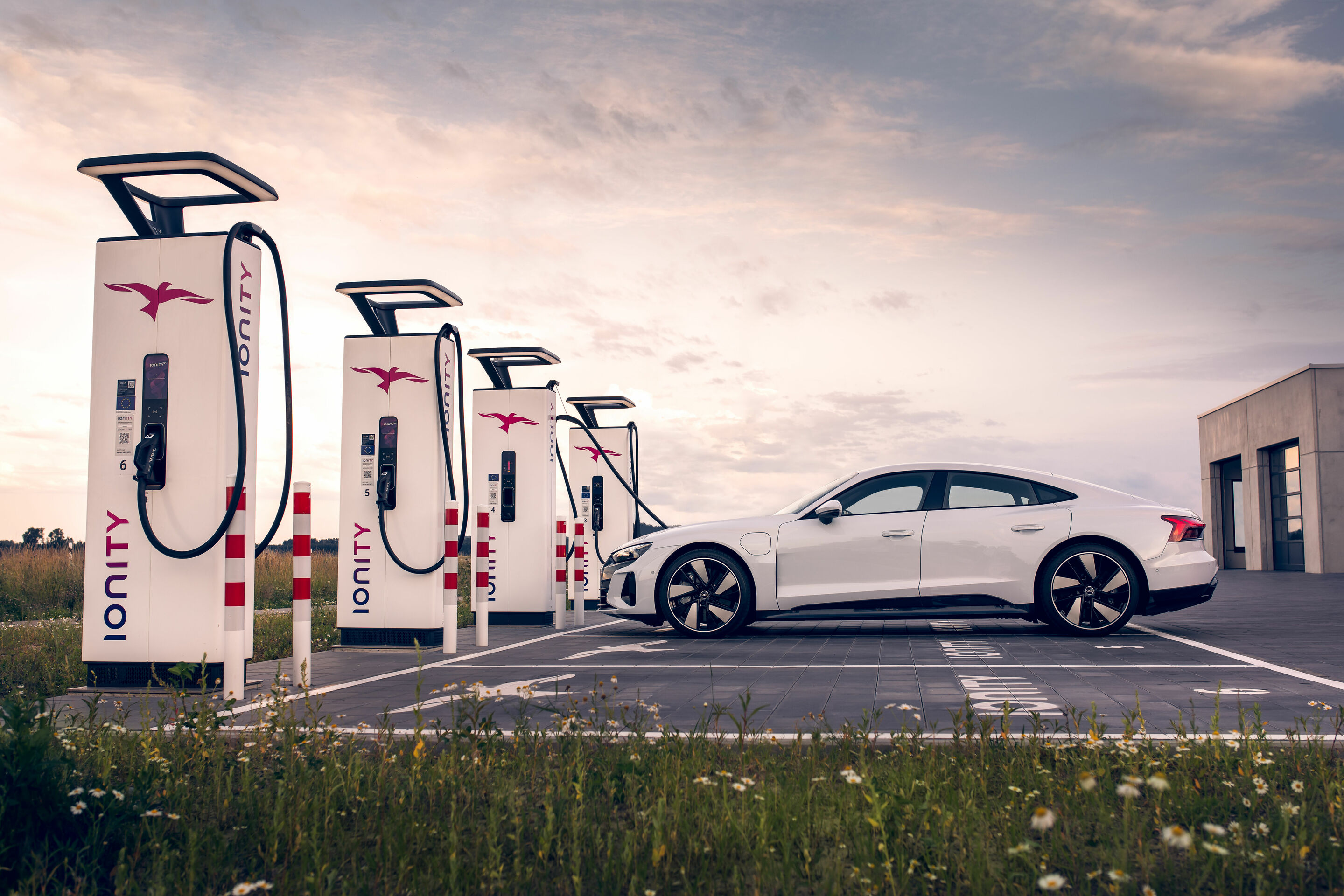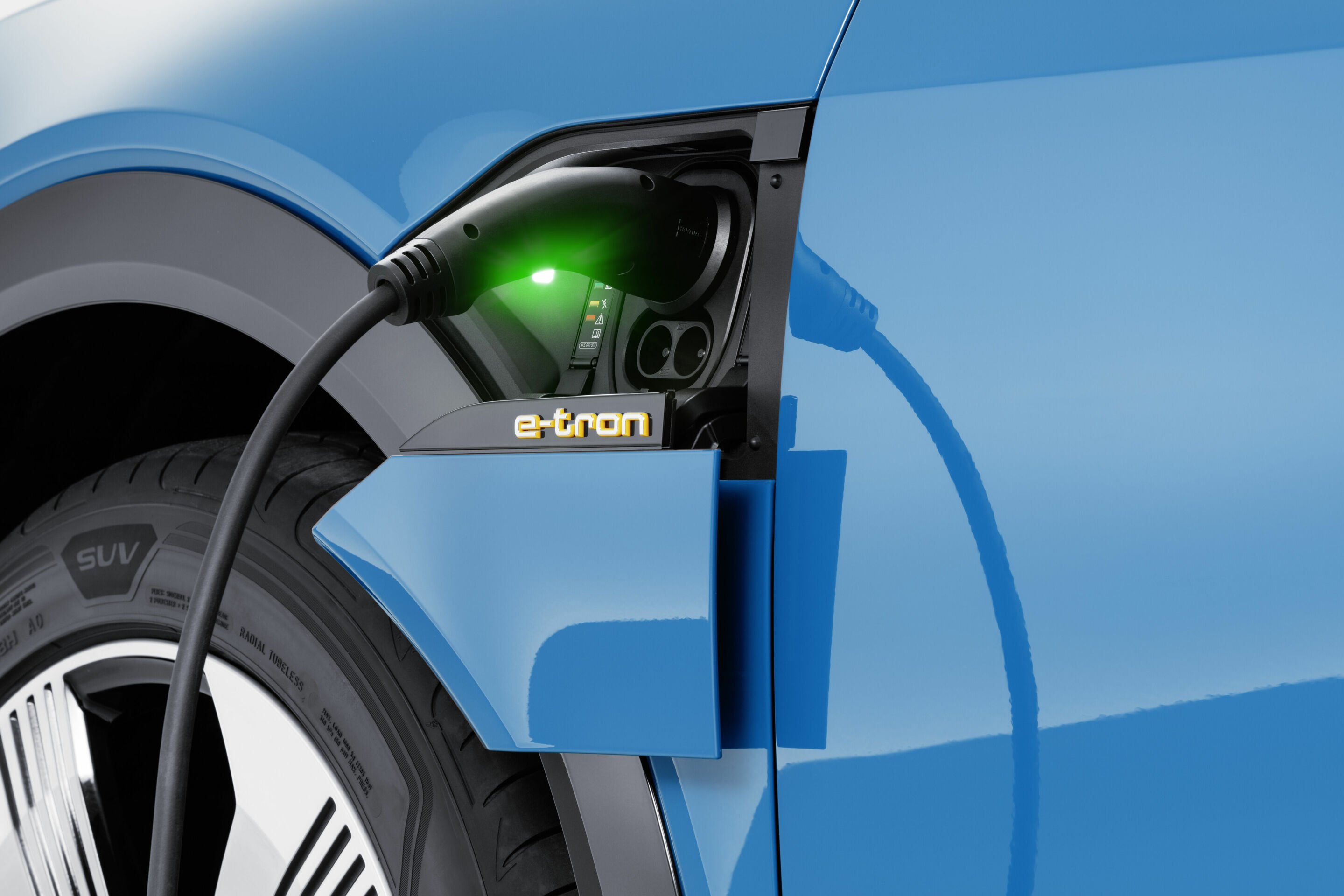Charging technologies
Back to overviewAudi offers a comprehensive and reliable range of charging options with intelligent solutions for at home and on the go. Alternating current, direct current, AC charging, DC charging – we explain the differences.
Note: The technologies described here reflect the state of development at Audi, either as it currently stands or as it has been in the past. Not all systems mentioned are available in the current model range.
AC charging (charging with alternating current)
Whether at home or at a charging station, when charging an electric car with three-phase alternating current using the type 2 plug common in Europe, the power is typically limited to 22 kW – in some cases 43 kW. Another limiting factor is the AC charger in the car itself. Its rectifier, which converts the three-phase alternating current into direct current for the battery, can only process a certain amount of power, measured in kW. The higher the power throughput is, the more waste heat is produced, which reduces efficiency. In order to minimize such losses, Audi integrates the three-phase AC charger into the low-temperature cooling circuit. For models built on the Premium Platform Electric (PPE) platform, the charging management system supports the international charging standard CCS (Combined Charging System). The HCP5 high-performance computer ensures fast and reliable charging processes as part of the new domain computer structure of the E3 1.2 electronics architecture. A communication control unit, the Smart Actuator Charging Interface Device (SACID), acts as an information interface between the charging socket and the charging station and forwards the incoming standardized information to the HCP5 domain computer.
For PPE models, Audi offers DC and AC charging options for the European market by providing a standard CCS combination socket on the rear left side of the vehicle. An additional AC charging connection is installed on the opposite side of the vehicle. The Q6 e-tron series comes standard with the familiar Plug & Charge function. At compatible charging stations, the vehicle authorizes itself when the charging cable is plugged in and activates the charging process at the station. The billing process then happens automatically.
DC charging (charging with direct current)
Power flows from the DC charger, which is integrated into the charging station, through the CCS type 2 plug (Combined Charging System), a dual AC/DC charging interface, directly into the vehicle’s battery. This enables high charging power. Sophisticated thermal management of the high-voltage battery, the 800-volt electrical system, and its ecosystem make charging a convenient, worry-free experience. For example, under ideal conditions, the Audi Q6 e-tron can charge enough energy for up to 255 kilometers of range in just ten minutes at a fast-charging station, reaching a maximum charging power of 270 kW. It takes just 21 minutes to charge the high-voltage battery from 10 to 80 percent. If a charging station operates with 400-volt technology, the Audi Q6 e-tron also supports bank charging. In that process, the 800-volt battery is automatically split into two batteries with equal voltage, which can then be charged in parallel with up to 135 kW. Depending on their state of charge, both battery halves are first equalized and then charged together. As standard, the Audi Q6 e-tron can fast-charge at high-power charging (HPC) stations with up to 270 kW. The charging flaps can be opened electrically via the MMI display or directly at the flap. After the charging cable is disconnected, the flap closes automatically. All drivers of fully electric Audi models also benefit from the Audi charging service and the fast-charging concept for urban areas, the Audi charging hub.
Audi charging
Audi customers of electrically powered models benefit from a reliable charging infrastructure on the road with the Audi charging service, available since January 2023, and the reservable fast-charging stations in urban centers – the Audi charging hubs. The Audi charging service offers uncomplicated access to a dense network of more than 630,000 charging points in 29 European countries. This includes more than 3,000 high-power charging (HPC) points from the provider IONITY, which enable fast charging with up to 350 kW of power, especially along the main traffic routes. Anyone who buys a new all-electric Audi can charge economically from day one, as Audi pays the basic fee for the pro tariff for one year. A complete overview of all current tariffs can be found at www.audi.de. The various contracts can be conveniently managed in the myAudi app.
How to charge
A number of features in Audi’s electric models help protect the high-voltage battery (HV battery) during charging to ensure a long service life – as well as significantly reduce charging times and noticeably simplify the search for charging stations. A number of factors play a decisive role in achieving optimal charging performance:
- Sufficient preconditioning
- Battery temperature kept within the ideal temperature range of +25 °C to +45 °C
- A low state of charge (SoC) when the charging process begins
- Moderate interior climate settings during the charging process
- Sufficient power output from the charging station/point
A high-voltage battery achieves its optimum charging performance between 25 and 45 degrees Celsius. If the temperature falls below this range, the battery’s internal electrical resistance increases, which significantly extends the charging time. Charging can also take longer at high temperatures if the charging current needs to be limited to protect the battery. That’s why the Audi Q6 e-tron, A6 e-tron, e-tron GT, and Q4 e-tron model series are equipped with predictive thermal management. This allows the car to preheat or cool the battery cells while en route to a high-power charging (HPC) station. Thanks to this “preconditioning” process, the HV battery reaches its optimal temperature range by the time the vehicle arrives at the charging stop. And during the charging process, the thermal management system keeps the temperature in the optimal range.
If you use the Audi e-tron route planner in the navigation system, preconditioning will be automatically activated for all charging stops along the route. The Audi e-tron route planner also provides up-to-date information on the number of charging points at a station, their charging power, the operator as well as availability at the charging station and payment options. Battery preconditioning is also activated when an HPC charging point is selected as an (interim) destination in the Audi navigation system. The process can also be started manually in the Q4 e-tron via the Audi MMI in the “Charging” menu.
IONITY
IONITY, Europe’s largest open high-power charging (HPC) network operating in 24 countries, is investing 700 million euros in its fast-charging network. The joint venture, in which Volkswagen is involved with the Porsche and Audi brands, plans to increase the number of powerful 350 kW charging points from the current level of more than 1,500 to roughly 7,000 by 2025. They will also no longer only be erected on highways, but also near major cities and along busy roads outside of city limits. As a result, the number of locations will also increase from just under 400 at present to more than 1,000. IONITY is also planning to expand many of its existing locations, depending on their demand. New locations will be designed with six to twelve charging points from the outset. That will significantly shorten charging times and wait times for Audi customers.
Audi charging hub
With reservable high-power charging (HPC) points and a directly adjoining lounge area in Nuremberg offering snacks, drinks, and nonfood items, the Audi charging hub transforms the time spent charging into a premium experience. By using so-called second-life modules – that is, battery cells from dismantled development vehicles – the Audi charging hub is also highly sustainable. Another major advantage is that the modules serve as buffer storage for direct current. This eliminates the need for a complex infrastructure with high-voltage connections and expensive transformers. Following the successful launch of the Audi charging hub in Nuremberg, Audi is continuing to roll out the charging concept. In November 2022, a compact version of the modularly designed Audi charging hub was opened in Zurich – with four covered charging points across two power cubes. Audi opened an additional compact hub in Salzburg at the end of 2022. Berlin and Munich followed in 2023. Frankfurt am Main and Tokyo, Japan, were added in 2024. Further locations are currently being planned for German cities.
Charging at home
The product range for at-home charging includes mobile charging systems for charging at power outlets, permanently installed Audi Wallboxes from VW subsidiary Elli, and complete home energy management systems from SMA Solar Technology AG and the Hagar Group, which intelligently control communications between all energy-related devices in a household. With varying functionality, the Audi Wallbox models with up to 11 kW of charging power are the right charging solution for a wide range of applications at home. The entry-level model – the Audi Wallbox – has an integrated charging cable. The Audi Wallbox plus can be controlled and monitored using an app. Other features include an integrated charging cable and a safeguard against unauthorized charging. The Audi Wallbox pro with an MID-certified (MID: Measuring Instruments Directive) energy meter, which can also be controlled via the app, is particularly recommended for drivers of company cars. With the e-tron charging system connect, designed for an output of up to 22 kW, customers can charge at low-cost times with a variable electricity tariff in conjunction with the compatible Home Energy Management System (HEMS). If the household has a photovoltaic system, the car can be preferentially charged using self-generated electricity. Forecasted periods of sunshine are taken into account in the charging schedule.
Charging timer
Charging performance at Audi also includes the so-called charging timer, which allows customers to set their exact departure time. This ensures that the automated charging process – with a preset battery level – takes place as close as possible to the set departure time. Additionally, preconditioning adjusts the interior temperature of the vehicle to the desired level before departure.
Plug & Charge
Thermal management
A sophisticated thermal management system is the basis for fast charging. A liquid cooling system ensures that the battery temperature remains within the optimal efficiency range of 25 to 35 degrees Celsius, even under high loads or in low temperatures. This technical design supports high charging and driving performance while also protecting the battery cells from excessive stress. Predictive thermal management, such as that used in the Premium Platform Electric (PPE), leverages data from the charging timer, user behavior, route profile, and navigation, including active route guidance with integrated charging stop planning. The PPE’s thermal management system also enables both postconditioning and continuous conditioning of the high-voltage battery, ensuring optimal performance and longevity.
route planner
The e-tron route planner, a service from Audi connect, calculates the fastest route with the shortest possible charging stops. The system bases its planning on the total travel time – that is, driving time plus charging time – factoring in forecasts for traffic conditions and the availability of charging stations. To ensure that drivers reach their destination as quickly as possible, it optimizes the segments between charging stops – sometimes recommending two short high-power charging sessions instead of one long, slower one. The list of charging points is updated daily.
Route planning can conveniently be controlled either in the vehicle or before the journey with the myAudi app. Users receive essential information such as charging power, connector types, and plug compatibility for each station. The system also displays real-time availability, indicating whether charging points are currently free or occupied. Alternative routes with better charging infrastructure are also taken into account when calculating the optimum total journey time. The up-to-date data includes detailed information such as payment and authentication options, operator details, and any access restrictions. The e-tron route planner prioritizes high-performance charging stations.
Charging for long and short distances
Regularly charging the HV battery to 100 percent puts additional stress on it and can accelerate battery aging. As a result, the usable battery capacity may decline more quickly over time. If the electric vehicle is primarily used for short trips, Audi recommends limiting the charge to a maximum of 80 percent. For long-distance travel, the full battery capacity should be utilized to maximize range – but ideally only charged to 100 percent shortly before departure so as to minimize gradual energy loss. Audi also recommends fast charging (high-power charging with more than 100 kW) mainly for long distances. If the vehicle is parked for an extended period of time, the battery’s state of charge should be kept between 30 and 80 percent – not too full, to avoid accelerating battery aging, and not too low, to ensure sufficient driving range when needed.


















